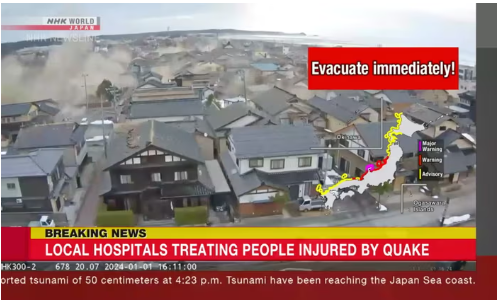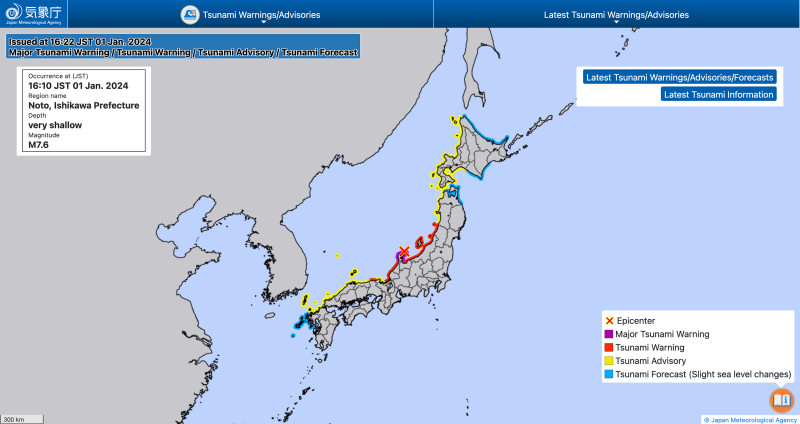More than 40 aftershocks of magnitude 3.5 and above have been felt since the 7.6 – Reports of people trapped – Homes without power – Roads severely cracked – No problems at nuclear reactors
The new year saw millions of Japanese on the streets after a magnitude 7.6 earthquake struck central Japan today, prompting a tsunami warning and advice for residents to evacuate coastal areas.
Horrifying footage from Japan!
Destruction aftermath the terrible 7.6 M #earthquake hits #Kanazawa of Ishikawa prefecture #Japan pic.twitter.com/iPbQCjS85z— WarMonitoreu (@WarMonitoreu) January 1, 2024
Warnings for strong aftershocks
Dozens of aftershocks continue to frighten residents since more than 40 earthquakes of magnitude 3.5 and above, have been felt since 7.6 Richter.
The Japan Meteorological Agency warned that strong aftershocks could continue for the next three days to a week. The agency urged people to be alert for possible building collapses and possible landslides in areas where strong tremors were felt. But Yoshimasa Hayashi, Japan’s chief cabinet secretary, at a press conference, warned of the risk of strong aftershocks.
2024 didn’t start in the best of ways in Japan.
A preliminary M7.6 earthquake hit central Japan, triggering a tsunami warning and advisories for residents to evacuate
The clip is from about an hour ago.
[📹 NHK]pic.twitter.com/7PlUQH5vF4
— Massimo (@Rainmaker1973) January 1, 2024
Visuals of destruction emerging after massive 7.4 magnitude #earthquake rocked Western #Japan. pic.twitter.com/k1rnydtoIO
— World Times (@WorldTimesWT) January 1, 2024
Visuals from Kanazawa City, Japan After Powerful Earthquake Of 7.6 Magnitude Hit Japan #earthquake #Japan #Tsunamipic.twitter.com/GA3ILk1Y1Q
— Sachiin Ramdas Suryavanshi (@sachiinv7) January 1, 2024
Disasters in houses, roads – Information for stranded people
Yoshimasa Hayashi, pointed out that Authorities are still collecting information on the damage. No casualties have yet been reported, however, the government spokesman said six cases of people trapped under the rubble of collapsed houses have been reported.
Train passenger captures moment western Japan was hit by a 7.6-magnitude earthquake pic.twitter.com/1ZemLCLUtz
— BNO News (@BNONews) January 1, 2024
At the same time, injured citizens are taken to hospitals with broken bones.
Some houses were destroyed and army units have been sent to help with rescue operations, Hayashi Yoshimasa, a government spokesman, told reporters, adding that authorities were still assessing the extent of the damage.
Stronger earthquakes in the region, where seismic activity has been concentrated for more than three years, may occur in the coming days, JMA official Toshihiro Shimoyama said.
Speaking to reporters shortly after the quake, Prime Minister Fumio Kishida also warned residents to prepare for more disasters.
“Residents should remain alert for possible further earthquakes and I call on people in tsunami-prone areas to evacuate as soon as possible,” Kishida said.
“Run!”, a bright yellow warning on television screens advised residents in certain areas of the coast to leave their homes immediately.
At the same time, approximately 36,000 households are without electricity.
High-speed train services in Ishikawa were suspended, while telecom service providers Softbank and KDDI reported disruptions to telephone and Internet connections in Ishikawa and Niigata, according to their websites.
Japan’s ANA ordered planes bound for airports in Toyama and Ishikawa to turn back, while Japan Airlines canceled most of its flights to the Niigata and Ishikawa regions, and authorities said one of Ishikawa’s airports was closed.
A tsunami warning has been issued
A major tsunami warning has been issued in the province Ishikawa and in Niigata, Toyama, Yamagata, Fukui and Hyogo prefectures.
It is the first time major warnings have been issued since the March 2011 earthquake and tsunami that struck northeastern Japan. A total of 21 earthquakes of magnitude 4 or greater struck central Japan in less than 90 minutes, according to the JMA.
The issuance of a major tsunami warning means that there is a possibility of waves of more than three meters.
Footage broadcast by Japan’s public broadcaster, NHK
Meanwhile, parts of the western coast of Sakhalin Island and the mainland cities of Vladivostok and Nakhodka, located near Japan on Russia’s Pacific coast, are threatened by a tsunami, the state-run TASS news agency reported, citing officials.
Map of places where a tsunami can strike
According to TASS, Russia’s Emergencies Ministry denied earlier reports that evacuation of the population from areas at risk in Sakhalin is underway.
A tsunami warning was also issued for the east coast of North Korea. North Korean authorities stressed that waves of up to 2.08 meters high could reach its shores, Yonhap news agency reported.
Also, South Korea’s Gangwon Province warned residents to take precautions and move to areas of higher altitude after a strong earthquake hit north-central Japan today and triggered tsunami warnings, according to the Ministry of Interior and Security.
South Korea’s weather agency said earlier that sea levels in some parts of Gangwon Province on the east coast may rise after the initially estimated 7.6-magnitude earthquake struck north-central Japan and issued a caution warning.
It had reported that a tsunami of up to 0.3 meters could reach the east coast of South Korea from 11:29 to 12:17 today.
WATCH: Tsunami waves observed along the coast of western Japan. People being urged to evacuate pic.twitter.com/sY3bdpVZVc
— BNO News (@BNONews) January 1, 2024
Gangwon province told residents in emergency text messages to stay away from the coast and move to areas with higher altitude. The city of Shamchok advised residents to move to areas taller than a three-story building, the Ministry of Interior and Security said.
Earlier, U.S. and Japanese agencies warned of a possible tsunami that could reach a height of up to five meters on the northern coast of central Japan within a radius of 300 kilometers around the epicenter of the powerful 7.5-magnitude earthquake that struck the country today. which AFP invokes.
“A tsunami from this earthquake is possible within a radius of 300 kilometers around the epicenter along the coast of Japan,” the Pacific Tsunami Warning Center ((PTWC)) in Hawaii (United States) said. the Japan Meteorological Agency warned of a tsunami that could reach a height of up to five meters.
More footage from Kanazawa Station in Ishikawa, showing extreme tremors and people fleeing for cover. Very scary indeed. #japan #earthquake #tsunami pic.twitter.com/0uWmG6cYup
— Rowdy (@RowdyHere) January 1, 2024
No problem with nuclear reactors
Japan’s Nuclear Regulatory Authority said no problems have been confirmed at nuclear power plants along the Sea of Japan, including five active reactors at Kansai Electric Power’s Noi and Takahama units in Fukui prefecture.
Hokuriku’s unit in Shika, Ishikawa, which was closest to the epicenter, had already shut down two of its reactors before the quake for routine inspection and was unaffected by the quake, the agency said.
The largest earthquake ever recorded in the South Peninsula
The magnitude earthquake 7.6 degrees is the largest recorded in the South peninsula in state Ishikawa since records began in 1885, the Japan Meteorological Agency reports.
An agency official also says the tsunami warning issued earlier was the first major warning of its kind since March 2011, when Japan was hit by one of the strongest earthquakes on record.
He adds that there is an increasing risk of landslides and fires in the affected areas.
Source :Skai
With a wealth of experience honed over 4+ years in journalism, I bring a seasoned voice to the world of news. Currently, I work as a freelance writer and editor, always seeking new opportunities to tell compelling stories in the field of world news.












